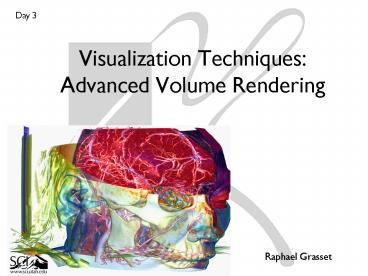Visualization Techniques: Advanced Volume Rendering - PowerPoint PPT Presentation
1 / 41
Title: Visualization Techniques: Advanced Volume Rendering
1
Visualization TechniquesAdvanced Volume
Rendering
Day 3
Raphael Grasset
2
Topics
- Interpolation
- Illumination and Non-Photorealistic Rendering
- Multimodal Rendering
- Advanced Transfer Functions
3
(No Transcript)
4
(No Transcript)
5
Effects of Interpolation
6
Effects of Interpolation
7
Solution Pre-Integrated Classification
8
Lighting Propagation in Volumes
- Until now we have considered transmission and
emission of light in the volume (i.e. opacity,
transparency) - We can also have
- Reflection of the light (like with surface
rendering) - Scattering of the light
- This will give us shading, translucency and
shadows
9
(No Transcript)
10
Principle
- Need an estimation of the Gradient of the volume
- Precomputed before rendering (issue for
time-varying data)
11
(No Transcript)
12
Ambient Lighting
13
Phong Shading Attenuation
14
Refraction
15
Reflections
16
Shadows
17
Translucency/Scattering
18
Global Light Illumination
19
Non-Photorealistic Rendering
- Not using a physical lighting model but rather
techniques from art and media design - Painting style
- Drawing style
- Cartoon Animation style
- Non Photorealistic Rendering vs Photorealistic
Rendering
20
(No Transcript)
21
Multimodal, Multichannel and Multivariate Volume
Rendering
Multimodal
Multichannel
Multivariate
22
Multimodal Volume Rendering
- N volumes how to mix them?
accumulation level intermixing (CT MRI)
Image level intermixing (time varying data)
accumulation level intermixing (time varying data)
23
Multichannel Volume Rendering
- Example cryosection of the Visible Human Project
- RGB slices? 3 scalars by voxels
- Conversion to another Color Space LUV
The u component (related to the chromatic change
in red-green colors)
The L component (related to brightness)
Gradients computed in Luv space, using the
second derivative along the gradient direction to
compute opacity.
Color difference gradient computed in RGB color
space
24
(No Transcript)
25
(No Transcript)
26
(No Transcript)
27
Improving Transfer Function
- Histogram
- First Derivative
28
Multi-Dimensional Transfer Function
29
(No Transcript)
30
(No Transcript)
31
(No Transcript)
32
(No Transcript)
33
(No Transcript)
34
(No Transcript)
35
(No Transcript)
36
(No Transcript)
37
(No Transcript)
38
Automatic Algorithm
- Exhaustive Set of TF
- (offline processing)
39
(No Transcript)
40
To Finish
- Graphics Card Capabilities have improved
tremendously over the last decades - A lot of computation can be done on your graphics
card (General Processing GPU, GPGPU) - Hardware Accelerated Volume Rendering (GPU
Rendering) - Development on the graphics card (GLSL, CUDA)
41
Summary
- Interpolation Issues
- Real Time Lighting of Volume Rendering
- Use of Illustrative Techniques for Volume
Rendering - Guidance Interface for Transfer Function
- Real-Time Volume Rendering on your Desktop































